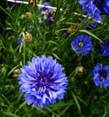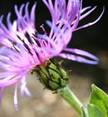Scientific Classification:
|
Other Common Names:
The other common names for centaurea cyanus are bachelor's button, bluebottle ,knapweed.A'Nber, Aciano, Blue Cap, Bluebow, Cornflour, Cornflower, Garden Cornflower, Hurtsickle, Korenbloem, Mawi Pighember Chichegi, Peygamber Cicegi and Sentoria.
History



Description
It is an annual herb, with an erect, wiry, downy stem that grows 1-2 feet high and is branching. At the ends of the branches grow solitary, thistle like, brilliant blue flower heads. Long grayish-green leaves are alternate, lance-shaped, and downy like the stem. The leaves, very narrow and long, are arranged alternately on the stem, and like the stem are covered more or less with white cobwebby down that gives the whole plant a somewhat dull and grey appearance. The flowers grow solitary, and of necessity upon long stalks to raise them among the corn. The bracts enclosing the hard head of the flower are numerous, with tightly overlapping scales, each bordered by a fringe of brown teeth. The inner disk florets are small and numerous, of a pale purplish rose colour. The bright blue ray florets, that form the conspicuous part of the flower, are large, widely spread, and much cut into. Range
A native of Europe and widely cultivated in North America, the cornflower has escaped from gardens and become naturalized. It is mainly found in corn field.
Habitat
Once a common weed of cornfields, as a result of modern agricultural practices it is now very rare in the wild. It is found especially on porous, nutrient-rich soils.
Cultivation
The plant prefers sandy, loamy and clay soils, requires well-drained soil and can grow in nutritionally poor soil. The plant prefers acid, neutral and basic (alkaline) soils and can grow in very alkaline soil. It cannot grow in the shade. It requires dry or moist soil and can tolerate drought. Tolerates dry, low fertility and alkaline soils. Established plants are drought tolerant. Seeds are generally sown in March in the greenhouse. When they are large enough to handle, prick the seedlings out into individual pots and plant them out in May. The seed can also be sown in situ during April, whilst in areas where the winters are not too cold a sowing in situ during September will produce larger and earlier-flowering plants.Flowering Season
The season lasts from late spring until the corn is harvested.
Pests and Diseases
Members of this genus are rarely if ever troubled by browsing deer.
Parts Used
 |
The entire herb is used in modern herbal medicine. |
Medicinal and Commercial Applications
- It is an astringent herb that reduces inflammation and also has tonic and diuretic properties. Taken in the water of plantain, Horsetail or the Greater Comfrey, it is a remedy against the poison of the scorpion and resisteth all venoms and poison.
- Traditionally it has been used to improve digestion, regulate the gall bladder, liver and kidneys as well as for menstrual disorders and to increase resistance to infections.
- The seed or leaves taken in wine are good against the plague and all infectious diseases and in pestilential fevers.
- The juice put into wounds doth quickly solder up the lips of them together and heals ulcers and sores in the mouth. It is very successful when used for washing out wounds. It is used with great success on mouth ulcers but its major application is for the treatment of the eye area and if used for corneal ulcers, conjunctivitis and minor wounds.
- It has antibacterial as well as antioxidant properties and is successful when included in eye products, since it has a gentle astringent effect, but also soothes inflamed and irritated skin.
- Cornflower flowers may be helpful in preventing the recurrence of urinary tract stones.
- The water that is distilled from the Cornflower petals has been used to treat weak or sore eyes.
- When Cornflower is dried as a powder, it is used to treat bruises. And when the leaves, seeds or distilled water of Cornflower is taken in wine, it is said that it is a guard against infectious diseases.
General Application
- The flowers are occasionally used for their tonic and stimulant properties, but the Blessed Thistle (Carbenia benedicta) which has similar properties is now more popular with today's herbalists.
- The Cornflower gives an infusion a bluish colour. Its main uses are in the treatment of dyspepsia and as an eye lotion.
- The expressed juice of the petals makes a good blue ink; if expressed and mixed with alum-water, it may be used in water-colour drawing.
- It dyes linen a beautiful blue, but the colour is not permanent. The dried petals are used by perfumers for giving colour to pot-pourri.
- Blue cornflower has been used to flavor teas and to reduce ocular inflammation.
- It is also sometimes added to shampoo and hair products.
- Flowers - raw or cooked. The fresh florets can be used in salads. They are used as a vegetable or a garnish.
- An edible blue dye is obtained from the flowers, used for colouring sugar and confections.
Folklore and Myths
"Cornflower blue" is the color of incredibly blue eyes. People lucky enough to have such beautiful eyes are especially likely to enjoy the plant's beneficial effect on the eyesight. Women wear this flower on their breast to attract the love of a man. Or, take a flower and put it in your pocket, it will lose or retain its freshness in accordance with bad or good success in amatory pursuits. 

